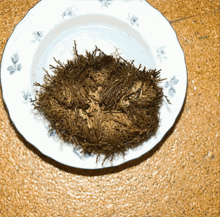| Revision as of 08:24, 31 October 2015 edit97.44.129.53 (talk) Added more info.Tags: Mobile edit Mobile web edit← Previous edit | Revision as of 08:41, 31 October 2015 edit undoNoyster (talk | contribs)Autopatrolled, Extended confirmed users, Pending changes reviewers, Rollbackers28,122 edits Reverted 1 good faith edit by 97.44.129.53 using STikiNext edit → | ||
| Line 1: | Line 1: | ||
| A '''resurrection plant''' is any ] plant that can survive extreme dehydration, even over months or years. | |||
| A '''resurrection plant''' is any ] plant that can survive extreme dehydration, even over months or years. The resurrection plant can be found from Texas to Arizona and as far south as el Salvador. Growing from rock out croppings or in dry soil. When the soil becomes moist after the rain, the resurrection plant absorbs water and grow rapidly. It produces a flat rossete of scaly stems up to one foot acroos. As the soil dries, it cannot store water, so it folds up it's stems into a tight ball, dries up, and goes into a state of dormancy. The folder plant has a limited surface area and conserves what little moisture is present. All metabolic functions are reduced to a minimum and the plant appears to be dead. It can remain in the dormant condition for years. When the rains return, the plants cells absorb the water and become hydrated. The attend unfold, metabolism increases, and growth resumes. Even dead resurrection plants will unfold if given water! The resurrection plants ability to seemingly return from the dead certainly justifies it's common name | |||
| ]'' reviving within 3 hours after the addition of water.]] | ]'' reviving within 3 hours after the addition of water.]] | ||
Revision as of 08:41, 31 October 2015
A resurrection plant is any poikilohydric plant that can survive extreme dehydration, even over months or years.

Examples include
- Anastatica hierochuntica, also known as the Rose of Jericho, a plant species native to deserts of North Africa
- Asteriscus (plant);
- Boea hygrometrica
- Haberlea rhodopensis
- Mesembryanthemum.
- Tillandsia
- Myrothamnus flabellifolius, a plant species native to Southern Africa
- Ramonda serbica, a species in the Gesneriaceae family
- Selaginella lepidophylla, a plant species native to North America, Central and South America, and sold as a novelty
- Lichen, a symbiosis that can survive in extreme desiccation
Certain resurrection plants have long been sold in their dry, "lifeless" form as curiosities. This custom was noted by many 19th century authors, and continues today.
See also
- Dehydration
- Cryptobiosis
- Anhydrobiosis
- Hygrochasy
- Pleopeltis polypodioides, the resurrection fern
References
- ^ Liberty Hyde Bailey (1916). The Standard Cyclopedia of Horticulture. Vol. 5. The Macmillan company. pp. 2920–2921, 3639.
- Zhang, T.; Fang, Y.; Wang, X.; Deng, X.; Zhang, X.; Hu, S.; Yu, J. (2012). Badger, Jonathan H (ed.). "The Complete Chloroplast and Mitochondrial Genome Sequences of Boea hygrometrica: Insights into the Evolution of Plant Organellar Genomes". PLoS ONE. 7 (1): e30531. doi:10.1371/journal.pone.0030531. PMC 3264610. PMID 22291979.
{{cite journal}}: CS1 maint: unflagged free DOI (link) - "Resurrection Plant". Faculty.ucc.edu. Retrieved 2012-01-30.
If an internal link led you here, you may wish to edit the linking article so that it links directly to the intended article.
This botany article is a stub. You can help Misplaced Pages by expanding it. |